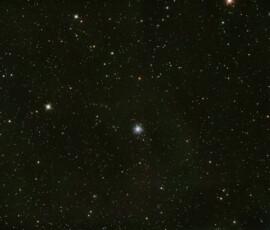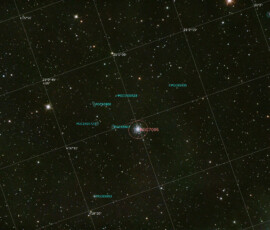NGC 7006 (also known as Caldwell 42) is a globular cluster in the constellation Delphinus. NGC 7006 resides in the outskirts of the Milky Way. It is about 135,000 light-years away, five times the distance between the Sun and the centre of the galaxy, and it is part of the galactic halo. This roughly spherical region of the Milky Way is made up of dark matter, gas and sparsely distributed stellar clusters.
NGC 7006 appears in the science fiction novel Beyond the Farthest Star by Edgar Rice Burroughs, where it is used as a point of reference by the inhabitants of the planet Poloda to determine the approximate location of Earth.

NGC 7006
NGC 7006 (also known as Caldwell 42) is a globular cluster in the constellation Delphinus. NGC 7006 resides in the outskirts of the Milky Way. It is about 135,000 light-years away, five times the distance between the Sun and the centre of the galaxy, and it is part of the galactic halo. This roughly spherical region of the Milky Way is made up of dark matter, gas and sparsely distributed stellar clusters.
NGC 7006 appears in the science fiction novel Beyond the Farthest Star by Edgar Rice Burroughs, where it is used as a point of reference by the inhabitants of the planet Poloda to determine the approximate location of Earth.
Photographed with the RC8″ reflector telescope and the ASI 2600MC CMOS color camera in Stuvsta, September 8th, 2024. Exposure was 40 * 2 min with IDAS LPS P3 light pollution filter. Postprocessing in Pixinsight with Blur Xterminator.

NGC 7006
NGC 7006 (also known as Caldwell 42) is a globular cluster in the constellation Delphinus. NGC 7006 resides in the outskirts of the Milky Way. It is about 135,000 light-years away, five times the distance between the Sun and the centre of the galaxy, and it is part of the galactic halo. This roughly spherical region of the Milky Way is made up of dark matter, gas and sparsely distributed stellar clusters.
NGC 7006 appears in the science fiction novel Beyond the Farthest Star by Edgar Rice Burroughs, where it is used as a point of reference by the inhabitants of the planet Poloda to determine the approximate location of Earth.
Photographed with the RC8″ reflector telescope and the ASI 2600MC CMOS color camera in Stuvsta, September 8th, 2024. Exposure was 40 * 2 min with IDAS LPS P3 light pollution filter. Postprocessing in Pixinsight with Blur Xterminator.